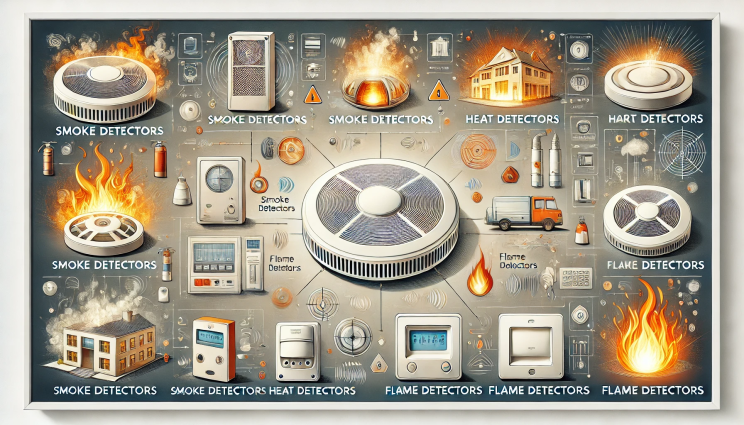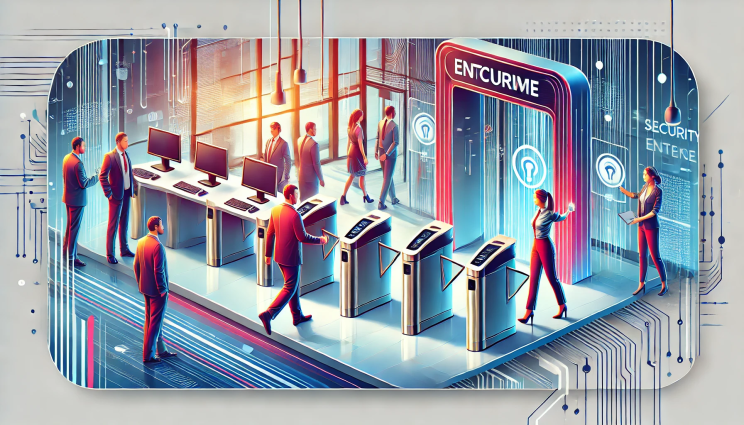Safety at the enterprise
Every company, regardless of its size or industry, faces numerous security challenges. From protecting assets and confidential data to preventing life-threatening incidents, all these aspects demands careful attention and effective solutions. In today’s ever evolving risk landscape, a robust security system is not just an option, but a necessity for sustainable business growth.
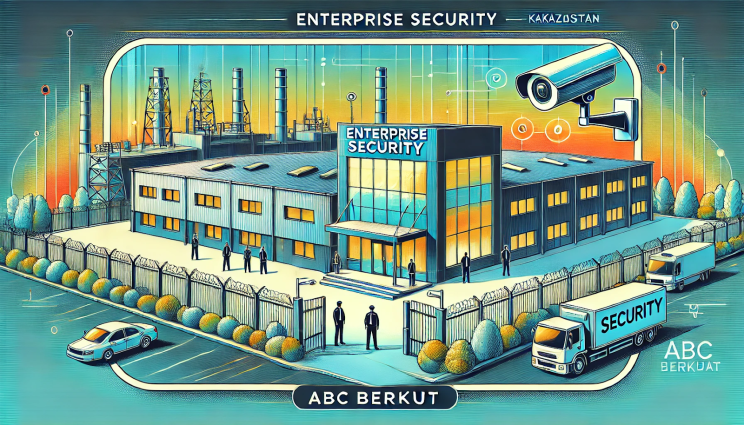
Ensuring security at an enterprise is a set of measures aimed at preventing possible threats and reacting promptly when they occur. It is important to consider both external risks, such as theft and vandalism, and internal risks, including data leaks and production incidents. A properly organised security system reduces potential risks, creating a safe working environment, having a positive impact on business efficiency and building the trust of employees and partners.
This article will provide a detailed overview of key aspects of enterprise security (including technical systems, organisational measures and best practices with the help of Kazakhstan’s leading security services provider, ABC Berkut). You will learn how to properly set up a security service, which technologies to use for monitoring and control, and how to develop a robust strategy to safeguard your business from modern threats.
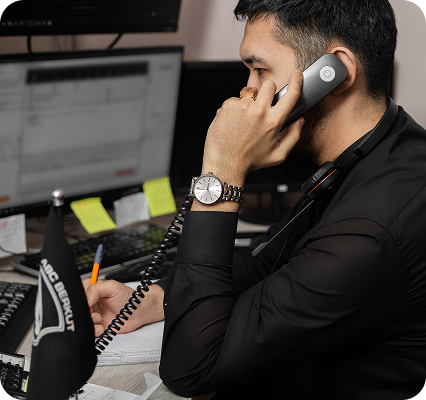
The significance of comprehensive security: addressing from external threats to internal risks
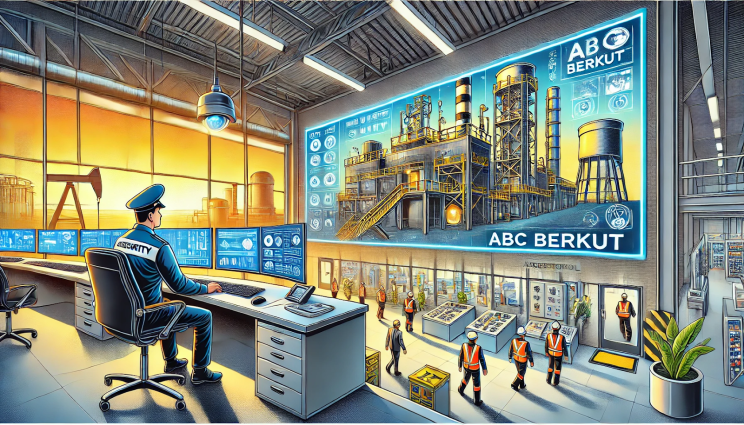
In today’s business world, safety goes beyond simply protecting assets. Companies face a variety of threats that can come from both outside and inside the organisation. External risks include theft, vandalism, intruders and cyber-attacks that can disrupt systems and leak confidential information. Besides causing material damage, such incidents also undermine the trust of customers and partners.
However, internal threats are no less serious. Employee misconduct, process errors or failure to comply with safety regulations can lead to accidents, workplace injuries and financial losses. Internal security also includes protecting data from accidental or deliberate leaks, especially in the age of digitalisation and remote working.
An integrated approach to security minimises the impact of both external and internal factors. The integration of various security systems, such as access control systems (ACS), video surveillance, panic buttons and rapid response services, provides a multi-layered defence of the enterprise. In addition to preventing potential threats, this also ensures a rapid response in the event of an incident.
Besides technical solutions, an organisational approach plays a key role in ensuring security. The introduction of clear regulations, regular staff training and audits help to identify and eliminate vulnerabilities in a timely manner, preventing potential risks. Creating a safety culture within the company increases employee awareness and responsibility for protecting corporate resources.
Attention to integrated security is becoming an integral part of the strategy of a successful enterprise. With the number of threats constantly growing and their forms becoming more complex, only an integrated approach can ensure reliable protection and business resilience to various challenges.
Corporate safety from the leader of security services ABC Berkut

Ensuring security at an organisation is a multifaceted task that requires a comprehensive approach and professionalism. ABC Berkut acts as a reliable partner, offering advanced solutions that cover all aspects of business security. Co-operation with the market leader in security services provides access to unique advantages to help create a safe and stable working environment.
Key benefits of working with a recognised expert in the security industry
ABC Berkut stands out in the market thanks to a combination of experience, innovation and a personalised approach to each customer. The company offers the following benefits:
- High level of professionalism. The ABC Berkut team consists of carefully selected specialists who have undergone rigorous selection and regular training. This guarantees high competence and readiness for any challenge.
- Cutting-edge technologies. The use of advanced video surveillance, access control systems (ACS) and intelligent panic buttons ensures reliable monitoring and instant response to any incidents.
- Customised solutions. Realising the unique needs of each business, ABC Berkut develops customised security programmes tailored to the specific requirements and infrastructure of the client.
- 24/7 support. A 24/7 security service provides a rapid response to any threats at any time of day, ensuring your business is protected constantly.
A professional approach solves several tasks at once: from preserving property to protecting employees
A comprehensive approach to safety enables a multitude of tasks to be effectively addressed, providing a well-rounded defence for the enterprise. This is demonstrated in several key areas:
- Property preservation. The integration of video surveillance and access control systems prevents unauthorised entries and thefts. Mobile Rapid Response Teams (RRT) promptly eliminate threats, minimising financial losses.
- Employee protection. Providing a safe working environment improves morale and productivity. Qualified guards control order on the company’s premises, preventing possible conflicts and protecting personnel.
- Emergency management. Creating and implementing evacuation plans, conducting regular drills and training employees in emergency situations help to respond quickly to unforeseen circumstances, minimising the risks of injury and loss.
- Data protection. In the digital age, protecting confidential information has become a priority. ABC Berkut implements access control and monitoring systems to prevent data breaches and safeguard vital information.
- Regulatory compliance. The company helps companies to comply with legal regulations on labour and fire safety, which not only protects the business from legal risks, but also strengthens their reputation in the market.
The integration of these elements into a single security system provides a multi-layered defence that can effectively counter both external and internal threats. ABC Berkut provides solutions designed not only to protect assets but also to create a safe working environment, contributing to the sustainability and success of your business.
Co-operation with ABC Berkut is a confident step towards creating an effective security system to provide comprehensive protection for your business. The company’s professional approach allows you to reliably protect property, personnel and confidential information, increasing the stability and competitiveness of your enterprise.
Vulnerability analyses and risk types
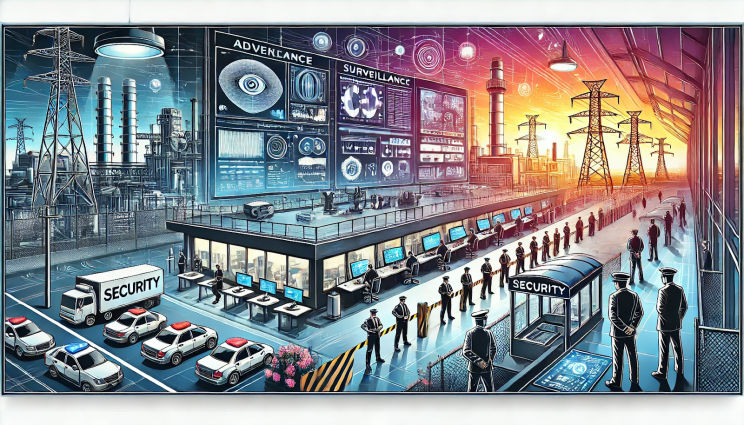
Modern businesses constantly face threats that can affect their safety and reputation. Key vulnerabilities include industrial espionage, data breaches and emergencies, every one of which requires timely assessment and prevention.
Industrial espionage
Businesses are often targets for competitive intelligence operations. Vulnerable networks, inadequately trained staff or lack of internal movement control can create entry points for intruders. Such breaches may result in the exposure of trade secrets or confidential information.
Data leakage
The digitalization of many processes creates new opportunities for hackers. Cyberattacks on servers, phishing schemes and malware infections can lead to serious consequences, including financial losses and a decline of customer trust. Effective data protection requires a well-thought-out strategy and constant security upgrades.
Emergencies
Unforessen incidents such as fires, natural or industrial accidents also pose significant risks. Without a clear action plan, the consequences can be catastrophic, ranging from financial losses to threats to employee safety.
Regular audits as control method
Regular safety audits play a key role in minimising these risks. System checks, analyses of possible threats and assessment of current protection measures help to identify vulnerabilities in a timely manner. A comprehensive approach includes both technical solutions and staff training to reduce the potential for emergencies.
Our constant attention to safety, systematic analysis of the situation and application of innovative technologies enable the business not only to minimise risks, but also to develop confidently while maintaining competitive advantages.
Technical safety systems
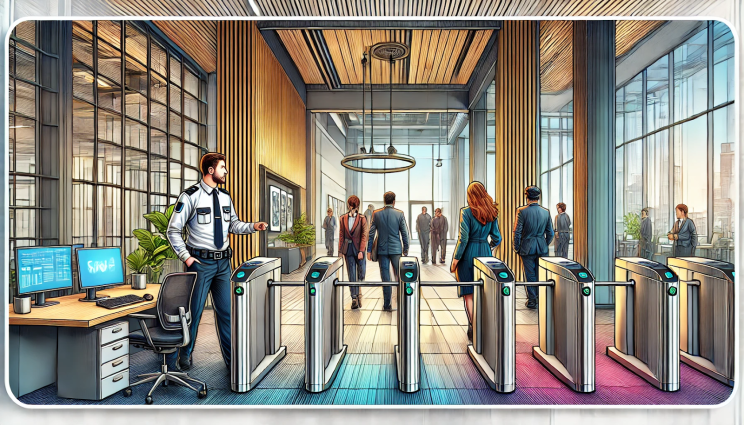
Modern security challenges require a multi-layered approach where technical defence systems play a key role. They ensure control, monitoring and prompt response to any threats.
Main elements of technical security systems
- Access control system (ACS). ACS ensure limited access to a facility for unauthorised persons, increasing the security level of the premises. Depending on the requirements, standalone or integrated solutions with access cards, biometric identifiers or code locks can be used. The main function of such systems is to prevent unauthorised entry.
- Video surveillance. Modern cameras provide high resolution recording, night vision and analytical capabilities e.g. facial recognition or motion detection. It is an effective tool for monitoring the territory and quickly identifying threats.
- Alarm button. A panic button provides instant notification of a security centre or a rapid response team (RRT). Setting such buttons at strategic points in the office or home significantly increases the efficiency of response.
- Smart sensors. Motion, smoke, glass breakage and gas leakage sensors detect potential dangers before they materialise. Combined with other systems, they create a highly effective defence.
- Remote control security. Remote monitoring systems integrate all security elements, providing continuous monitoring of the object and prompt response. Centralized monitoring enables the integration of video surveillance, ACS and sensors into a unified system.
Integration of systems into a common security system
For maximum effectiveness, it is crucial not only to install technical systems, but also to integrate them properly into the overall security solution. This includes:
- Process automation: integration of ACS, video surveillance and sensors via centralised software.
- Synchronisation with remote control security: to ensure timely response.
- Integration with smart systems: умные технологии позволяют анализировать данные в реальном времени, минимизируя ложные срабатывания.
- Regular equipment upgrades: timely modernisation helps to meet current safety standards.
Technical safety systems, such as ACS, CCTV, panic buttons and intelligent sensors form the foundation of a reliable security complex. Their proper integration with remote monitoring and regular upgrades ensure the protection of facilities of any complexity.
Security service management in the enterprise: structure, functions, authority
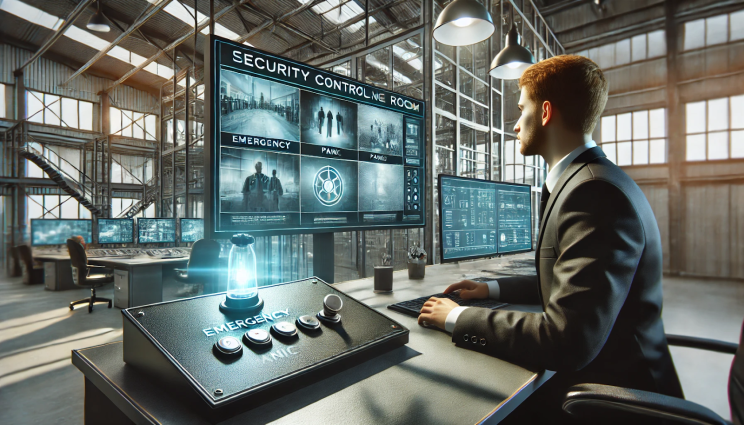
Security service organisation at a company is an integral part of sustainable business operation. An effective system helps minimise risks and protect assets, data and personnel.
Security structure
A business security service includes several key elements, using each of them to fulfil certain functions. The key links of the structure:
- Security Management. Responsible for developing strategies, making decision and co-ordinating all actions within the service.
- Analytical department. Performs risk assessment, threat analysis and develops measures for their prevention.
- Operational unit. In charge of monitoring facilities, responding to incidents and implementing safety measures.
- Technical department. Responsible for the installation, maintenance and modernisation of technical safety equipment e.g. ACS, CCTV, alarms etc.
- Human resources. Controls employee access, conducts personnel checks, and trains employees on corporate security principles.
Functions and powers of security service
The security service unit performs its own unique functions, but their activities must be harmonised. The main tasks of the service:
- Data protection. Ensuring the confidentiality of corporate data and preventing leaks.
- Access control. Installation of ACS and implementation of an entry control procedure to restrict access to the enterprise premises.
- Physical Security. Protection of the company’s property, control over compliance with internal order.
- Threat monitoring and prevention. Analyse potential risks, identify incidents and remediate them.
- Interaction with government agencies. Co-operation with law enforcement agencies to resolve incidents requiring external intervention.
Building corporate security from scratch
Starting a security organisation from scratch requires a comprehensive approach:
- Current risk analyses. Conduct an audit to identify weaknesses, potential threats and develop a defence strategy.
- Control model selection. Examples of approaches can range from a fully in-house safety service to the involvement of professional outsourcing companies.
- Technical systems implementation. The installation of access control systems, video surveillance, alarm systems and other modern means of protection.
- Employee training. Providing briefings and training sessions to raise employees’ awareness of safety measures.
- Security policy development. Creating regulations describing the actions of employees in various situations, including emergencies.
Coherence and accountability
In order for the security service to work effectively, co-operation between departments is essential. This is achieved by:
- Regular meetings. Discussion of current threats, reports and action plans.
- Common standards. Implementation of universal rules that are understood by all participants in the process.
- Periodic reports. Prepare regular summaries of incidents, actions taken and overall security status.
A company’s security service is a complex structure that ensures the stability and protection of the business. Coordination between departments, competent strategy and regular reports create an effective system capable of coping with the challenges of the modern world.
Fire safety and technological processes: minimising risks at work
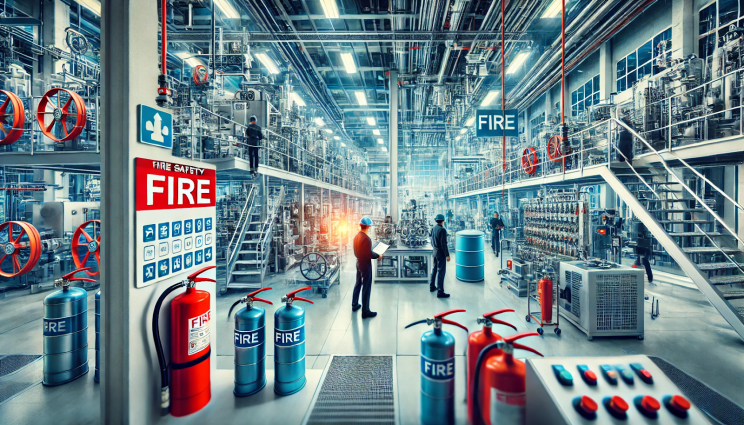
Fire safety in industrial enterprises plays a key role in protecting employees, equipment and work processes. Failure to organise these measures correctly can lead to serious consequences including major financial losses, production stoppages and endangering personnel’s lives.
Crucial aspects of fire safety at industrial facilities
- Risk Identification. The first step in fire safety is a detailed analysis of possible sources of burning. At production facilities, these may include:
- Sparks or overheating of equipment.
- Leaks of flammable gases or liquids.
- Personnel errors when operating machinery.
- Electrical shorts.
- Compliance with norms and standards. All technological processes and equipment must comply with established state fire safety regulations. This includes proper equipment placement, the use of non-combustible materials in structures and ensuring access to fire exits.
- Early detection systems. Modern fire safety systems including smoke, heat and gas detectors are key components for rapid incident response. Connecting these systems to centralized monitoring stations enables the immediate dispatch of the firefighting teams.
- Provision of fire-fighting equipment. Having fire extinguishers, fire hydrants, automatic suppression systems (e.g. sprinkler) helps minimize fire damage. Special attention should be given to regular maintenance and perfomance checks of these systems.
Implement regulations, evacuation plans and early warning systems
- Regulations and guidelines. The development of detailed fire safety instructions is the basis for preventing emergency situations. These documents must take into account:
- Duties of personnel in case of fire.
- Evacuation procedures.
- Fire prevention measures.
- Evacuation plans. Every industrial facility must develop and display evacuation plans in visible locations. These plans should be easy to read, include clear directions to the nearest exits and take into account building features such as:
- Presence of multiple floors.
- High hazard areas.
- Hazardous material storage areas.
- Public address systems. Audible and visual alarm systems are used to promptly inform employees about a fire. These systems should be integrated with fire detection sensors to ensure automatic activation in case of an emergency.
- Staff Training. Regular evacuation and emergency drills enhance employees’ readiness for swift action. Additionally, they help identify and eliminate weaknesses in existing procedures.
Reliable fire safety at industrial facilities is based on integrated measures that include modern technology, clear regulations and employee training. Installation of early fire detection systems, development of effective evacuation plans and strict compliance monitoring help to reduce risks and prevent serious consequences of emergency situations.
Rapid Response Team: prompt departure as a guarantee of stability
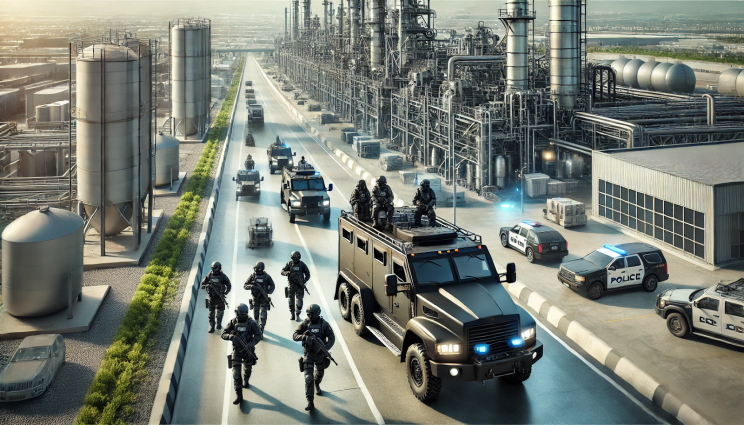
In today’s world, where decision-making is critical, the Rapid Response Team (RRT) plays a key role in ensuring stability and security. These mobile units are designed for immediate response to potential threats, emergencies and public order violations.
The role of RRT mobile crews in prevention of offences and emergency response to threats
The key goal of the RRT is to respond swiftly to alarm signals from protected facilities. Due to constant readiness, the crews prevent potential incidents at the earliest stage.
- Patrolling & Monitoring. Regular patrolling of areas and routes reduces the potential for offences. Showing the presence of the crew disciplines potential attackers, minimising risks.
- Emergency intervention. If you receive an alarm signal, the RRT immediately arrives on the scene. Whether triggered by a security system, a panic button signal or a message from the dispatch service, the specialists assess the situation, preventing a conflict from development.
- Providing protection for personnel and property. Rapid response teams not only prevent theft, break-ins and vandalism, but also act quickly in situations that threaten the safety of people, including attempted assaults or intrusions.
Benefits of on-time arrival of specialists over traditional guarding formats
- Immediate response. The flexibility of the RRT can significantly reduce the time of arrival at the site compared to police or traditional security methods. The average response time is only a few minutes.
- Highly professional training. Team members undergo specialized training including tactical manoeuvring, negotiation and the lawful use of force. This ensures they are prepared for any scenario.
- Integration with modern technology. Utilising navigation systems, direct communication with the control panel and data analysis enables crews to operate efficiently and cohesively. Technical support includes real-time monitoring of alarm zones.
- Multitasking. The RRT can perform a wide range of tasks, from preventing minor offences to participating in the elimination of serious threats. This versatile security format complements other forms of safety.
The Rapid Response Team plays a crucial role in the security system, providing a swift response to emergency situations. With high mobility, professional training and the ability to prevent threats, the RRT is a vital component of defence. In situations where every second matters, the rapid deployment of specialists guarantees the safety of people, property and public order.
Conclusion: key steps to building a strong security system
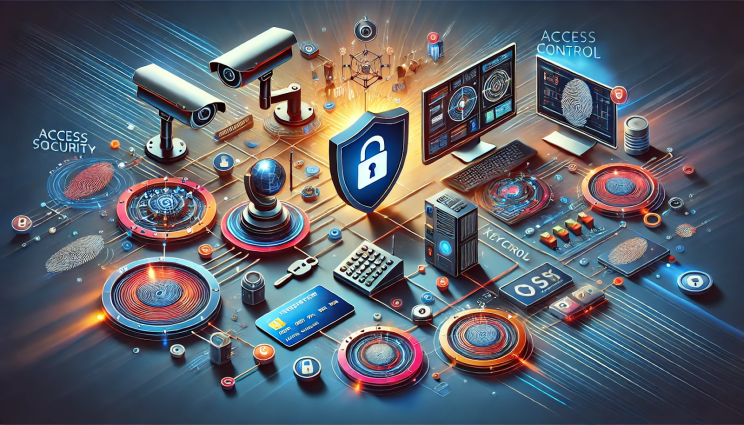
Building an effective security system requires a detailed approach, thoughtful planning and the implementation of modern technologies. Providing maximum protection through regular risk analysis, consideration of the specifics of the facility and rapid adaptation to changes. Only a combined approach, application of innovative solutions and compliance with established standards guarantee safety and stability.
ABC BERKUT provides a complex approach to security at any site. We apply the latest technologies, train our personnel to the highest standards and take into account all individual customer needs. When you choose to entrust your security to professionals, you choose confidence, comfort and reliability.
